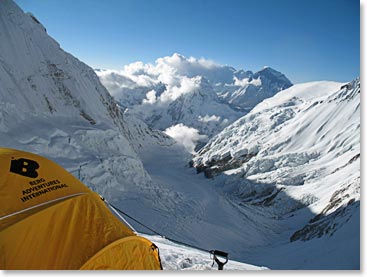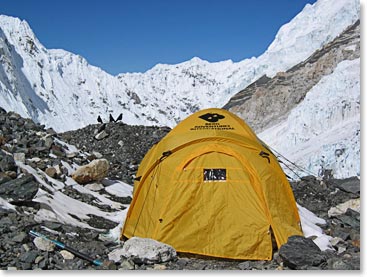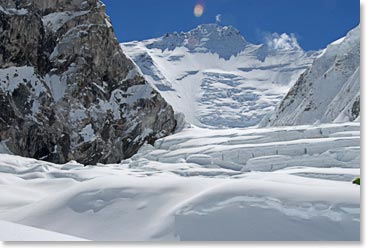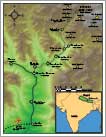
Berg Adventures 2013 Everest Expedition Dispatch
May 1, 2013 – Second Rotation Successful: The Guys Sleep at Camp III
Steve Whittington, Daniel Branham and Todd Pendleton called us on the radio at 10:30 this morning with the happy news that they were off the steep fixed lines and they had stepped across the bergschrund that separates the Lhotse Face from the Western Cwm. Steve announced that they were going to continue their descent by strolling down the relatively flat section of glacier to Camp II, where Tashi and Dawa Nuru had lunch waiting. It was not a surprise for us to hear from the guys that they did not sleep especially well on their first night over 24,000 feet last night, but they sound healthy and happy today. With the night at Camp III, an important “rite of initiation” for climbers who go over 8000 meters on Everest behind them now, our team can bring their “second rotation” on the mountain to an end. They told me that they are looking forward to returning to Base Camp tomorrow – eating, bathing and relaxing.

The majestic beauty of the “Valley of Silence” from Camp III
The guys had an interesting experience however, one that is not at all unknown to many previous Everest climbers. They will soon be calling home by sat phone and may be questioned by loved ones and friends about what the real “news” on Everest is. They were at Camp II on April 27th, and they remained at Camp II until yesterday, when they climbed the excellent fixed lines which had been placed by the Sherpas to Camp III. But the reports that dominated cable news and print media around the world for a couple of days, and which now is the subject of countless blogs, and internet reports, did not concern or affect Daniel, Todd and Steve. Their personal blogs and posts on our site will tell you about what has been going on with them in recent days: acclimatization and enjoying the majestic beauty of the “Valley of Silence.”

Camp III visitors

Lhotse face from Camp I
Because of comments and questions to Berg Adventures’ own posts on the internet I feel that it is important to post what I feel is the best single thing that I have come across that has been written about the incident at Camp II a few days ago. Garrett Madison wrote this thoughtful and accurate piece based on his own involvement as an Expedition Leader and on his talks with guides, Sherpas and climbers. I agree with his account and his conclusions 100%. Before you read Garrett’s account I will offer a few of my own observations.
- I have known some of the Sherpas who were at Camp II on April 27 for nearly 30 years. Virtually all the other Sherpas who were there are the sons, nephews, cousins of the men who I have known for so long. Tension, fear, doubt are not new emotions for these guys. They know the humility that all real mountaineers face in the highest places; we feel small and frail, we’ve lost friends and peers.
- Simone Moro was genuinely apologetic to the Sherpas that he scuffled with when he was here at Base Camp on April 28th. And by the accounts related in Garrett’s piece below, the apologies were beginning even at Camp II, while emotions were so hot and high. The danger in these situations is bystanders trying to “take up” for someone. Simone’s climbing may or may not be over for this season. But he assured everyone at our meeting here at Base Camp that he would be back soon flying his helicopter and offering rescue and support services at Base Camp. My guess is that Simone Moro and the Sherpas will be just fine. No one else needs to take up a cause or a moral stance on the behalf of either party.
- Much can be said today, May 1st, about the 50th anniversary of Jim Whittaker and Gombu Sherpa’s first American Ascent of Everest, as well as this entire month about the 60th anniversary of Hillary and Tenzing’s ascent. It is a good time to reflect on the long history of camaraderie between foreign climbers and Sherpas. In all the history of exploration and climbing there is nothing quite like it. But I also feel it is important to recognize how different things are in 2013. The sons and nephews of my older Sherpa friends, the new generation, are technically competent, proud mountaineers. They are graduates and instructors at the Khumbu Climbing School. Many of them will leave for guiding jobs in the US after this Everest season is over. I will see others in the Caucasus Mountains in Russia or in Antarctica later this year. They have every bit of the ego investment and pride in their craft and their profession that every other mountain guide that I have ever known has. Garrett’s account below is spot on. At our team leaders meeting on April 18th we agreed that 16 of the best climbers would fix the Lhotse Face, not because they were the only climbers here, or the only ones willing to go, but because it was an efficient cooperative strategy for the teams trying to reach the top of Everest via the South Col as well as for those trying to climb Lhotse. I think that we all wish the lads had just been allowed to get at it that day. In any event, they did just get at it two days later and the result was that Berg Adventures climbers had a great acclimatization ascent to sleep at Camp III yesterday.
Fight at Camp 2 on Everest
By Garrett Madison
As this story has emerged in the media it has become clear that the Sherpas have not been given a voice. The press releases, the blogging, and reports from the European climbers have dominated the headlines. Meanwhile the Sherpa are quietly continuing to fix the rope and continue their work at nearly 8000 meters on Everest. These Sherpa help realize the dream of many western climbers and will continue to be honored and respected by the foreign climbers who climb with them on Everest.
I have pieced together an objective version of events different from what is currently in the media headlines. These details are directly from what I heard on the radio on April 27th, my discussions with many people in base camp over the last 2 days including expedition leaders, western guides, and clients who were at Camp 2 during this incident, and Sirdars (head Sherpa) who directly supervise the fixing team.
On April 18th, 2013:
All expedition leaders and Sherpa Sirdars were invited and attended a meeting in Everest base camp to discuss the rope fixing strategy for this season on Everest. At this meeting everyone had a chance to suggest the best strategy and route to safely climb the mountain. The meeting concluded with the nomination of fixing Sherpas (the best available) and the suitable dates to complete the work. It was also agreed at the meeting by all the expedition leaders that nobody would be climbing on the route on these dates except the fixing team. That while these young men were working to fix the route for all expeditions at base camp, no expedition would disrupt or create a distraction for them. Unfortunately, Simone Moro did not attend this meeting, and might not have been aware that this protocol is an unwritten rule on Everest.
Over the next few days all the teams at base camp pitched in and Sherpas carried over 50 loads through the Khumbu Icefall to Camp 2. The fixing started on April 26th, for 2 days the Sherpa were scouting the best route on the Lhotse face and by the 27th they were less than an hour from reaching camp 3.
The 3 European climbers set out the morning of the 27th heading for the Lhotse face. After suggestions from both guides and Sherpa at Camp 2 and below the Lhotse face to turn around, because fixing the Lhotse face demands strict concentration, the 3 climbers continued on to the Lhotse face moving up and to the left of the fixing route. The 3 climbers moved alpine style up the Lhotse face and were headed towards their camp (just below camp 3 on the Lhotse face).
At this time the Sherpa fixing team were working on the Lhotse Face and have reached one of the steeper & more exposed areas. The temperature was dropping and the winds were picking up. As the fixing team was moving through a steeper section of the Lhotse face, the 3 European climbers met with the fixing team. The fixing team alerted the 3 climbers to not touch or cross the rope. This is a high intensity environment where people’s instincts are at a heightened state. The lead fixing Sherpa spoke with one of the 3 climbers at which point physical contact was made, at that point Simone came in verbal contact with a number of the fixing team who had now congregated at one of the anchors to secure themselves from sliding down the face.
Simone began to shout, many of the words in Nepali language, and many of the words were inflammatory. At this point the fixing team made the correct decision to drop their loads of rope and hardware, attaching them to the installed line, and descend without any further interaction or confrontation with the 3 climbers. The fixing team descended to camp 2 and went to their respective camps as a number of expedition teams work together to fix the route on Mt. Everest. As the fixing team descended to camp 2, Simone radioed down requesting to know what the Sherpa were talking about. At one point Simone stated over open radio frequency (fixing frequency-tuned in by all the fixing teams and anyone listening on the mountain) that if the Sherpa had a problem he could come down to Camp 2 soon and “f—ing fight”.
As Simone returned back to Camp 2 he again spoke over the fixing frequency a demand to speak with the fixing team comprised of 16 Sherpa (of 8 different teams) back at camp 2. He explained that he would meet them at one of the expedition camps. When he arrived in Camp 2 he went to his tent. At this point some western guides went to Simone’s camp to explain that he should apologize for the situation his team created during a very dangerous workday. As the western guides spoke to Simone, Sherpas from many different teams congregated as a result of his radio call from the Lhotse face and wanted to speak with Simone and get an apology and to explain to him how difficult their job had been that day. The Sherpas who were together felt that Simone’s words and interactions were both hurtful to the individuals, as well as grave and serious insults to the entire Sherpa community. As the Sherpas approached Simone’s camp tensions were high and they wanted to have a discussion with an already angered Simone. Then Simone came out to talk and both sides approached each other in loud discussion at which point a careless western climber who had not been involved up on the Lhotse face arrived and entangled physically with a Sherpa. This was the ignition for what ensued next. It is safe to say that the Sherpa thought this western climber was part of Simone’s team and had initiated a dangerous confrontation. At this point the Sherpa felt as if they needed to defend themselves as they had just seen one of their colleagues attacked. The tense situation ignited and a brawl ensued.
The brawl was stopped by a group of western climbers and Sherpa working together. Simone’s team was protected by both a Sherpa group and a few western climbers and guides. As the group separated, Simone requested to apologize for his actions. After things calmed down, Simone’s team descended to base camp. The following day, April 28th, was peaceful.
April 29th:
To Simone’s credit he did not want to leave Everest until he had a chance to make peace with the furious Sherpas. The Sherpa met in base camp and discussed peacefully the events of the fixing day (April 27th), and both parties recognized the errors in what they said and did, and apologized to each other. Simone reiterated his respect for the Sherpas and for the work they do and both sides agreed to work together in the future to make sure something like this never happens again.
The Sherpa community understands this unfortunate and avoidable situation was unacceptable. The Sirdars have committed to educate these hard working young men about handling the stresses of a very intense job.
In climbing the Nepalese side of Mt. Everest, all the teams collaborate in working together to ultimately achieve a mutual goal, to reach the top of Mt. Everest safely and the Sherpa are a major part of this goal. The first summit of Everest in 1953 was Sir Edmund Hillary and Tenzing Norgay, a foreigner and a Nepalese Sherpa. The first American ascent in 1963 was Jim Whittaker and Nawang Gombu Sherpa, also a foreigner and a Sherpa.
I sincerely hope that this incident does not damage how the Sherpas perceive the foreigners who come to climb on their mountain. We aim to uphold the spirit of climbing together to accomplish our common goals and to respect one another throughout our mountaineering endeavors.


